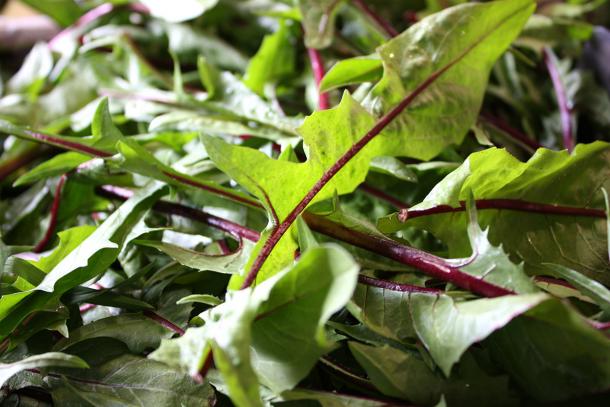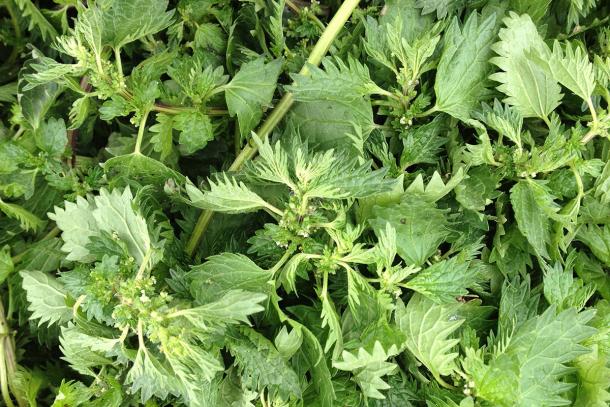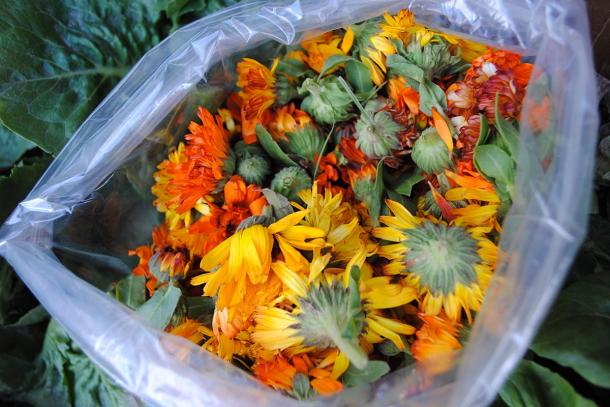8 Spring Farmers Market Superfoods You Should Be Eating
Leanne Tallis and Brie Mazurek
May 8, 2015
Spring is a time for detoxification and renewal, which makes it the perfect occasion to explore the diversity of fresh produce at the farmers market. While imported crops like quinoa and goji berries are often hyped as “superfoods,” there are plenty of nutrient-rich (but perhaps less familiar) foods that grow right here in our foodshed.
To find out about some of the local and seasonal superfoods available at the Ferry Plaza Farmers Market, we talked with Leanne Tallis, who studies herbal medicine and nutrition and works at the Heirloom Organic Gardens stand on Tuesdays. While you may know that blueberries and cherries are high in anthocyanins, red-purple pigments that work as antioxidants, we discovered a whole world of superfoods at the market that you generally won’t find on grocery store shelves.
Here are a few herbs, flowers, and greens Leanne recommends integrating into your springtime diet. Some of them may be considered “weeds” (or “volunteers,” to be more politically correct), but it makes them no less delicious and nutritious!
Borage
With a scent and flavor reminiscent of cucumber, borage is a beautiful herb whose telltale characteristic is a star-like purple flower surrounded by fuzzy leaves and stems. In herbal folklore, it was said that borage could “drive away sorrow and make the mind glad,” perhaps due to its high omega-3 fatty acid content. (Some natural practitioners today recommend a diet high in omega-3s to help fight depression.) The blossoms and leaves can be used in many different preparations, such as soup stocks, salads, smoothies, juices, or pesto or chimichurri.
Calendula
This bright and sunny flower is as beautiful as it is useful. Calendula is used in herbal medicine to heal a variety of conditions. Considered a “vulnerary,” or wound healer, calendula can be applied topically, usually in the form of an infused oil, to anything from chapped and chafed skin to bruises and sore muscles. It is also known to support the lymphatic system and to have antibiotic properties. One can make a tea, an alcohol extraction, or use the beautiful and peppery yellow and orange petals in a salad. You can also make a healing oil to use topically.
Chickweed

True to its name, chickweed is a wild-growing green that is also a nutritive tonic. “Chickweed water” was an old formula for weight loss and can be used to support issues involving the lymphatic system such as skin rashes or inflammation. The plant can also be applied topically in the form of a poultice to burns or inflamed areas. With a bright and grassy flavor that is likened to freshly shucked corn, raw chickweed adds wonderful nutrition to salads, juices, and smoothies.
Dandelion Greens

The body naturally wants to detoxify in the spring, and what better way to do this than with dandelion greens? In Traditional Chinese Medicine, it is said that the color of spring is green, and the taste of spring is bitter. Although they are available year round, dandelion greens are most tender and tasty in the spring. This common “weed” is a nutritional powerhouse. High in vitamins A, C, and E and minerals like iron, dandelion greens have a decidedly bitter flavor, which stimulates the body’s digestive system and can help support the liver. Dandelion greens can replace kale in many recipes. Just toss into a salad, stir-fry, pasta dish, or scrambled eggs. For those looking for a stronger detox, you can also add it to smoothies and juices (just go easy if you’re not used to bitter flavors!).
Lambsquarters
Sometimes referred to as “wild spinach,” “fat hen,” or “goosefoot” (due to the distinctive shape of the leaf), this salty and tasty green packs a powerful nutritional punch. It is considered a weed and usually grows wild. According to Joan Richardson’s Wild Edible Plants of New England, lambsquarters “outclasses spinach as a storehouse of protein, calcium, phosphorus, iron, vitamin C, and great amounts of vitamin A, not to mention all the minerals pulled out of the earth by its strong taproot.” One chef says it’s delicious prepared as traditional “creamed spinach.” It can be eaten raw or cooked and makes a nice addition to soups and sauces. Just remember: you won’t need to add much salt to your dish!
Nettle

There is a saying in herbalism that goes “when in doubt, use nettle.” Indeed, it would be hard to find a condition for which nettle couldn’t offer some healing support. Most commonly, nettle is used to treat allergies and add nutrients to the diets of those in need (such as pregnant women or the elderly). Nettle is usually a wild-growing weed and pops up in the spring through early fall. With its deep green color and characteristic sting, nettle is powerful medicine. It contains iron, calcium, potassium, zinc, copper, magnesium, and vitamins A, K, and E. Nettle can be made into a tea, an alcohol extraction (tincture), or added to a number of wonderful recipes. Handle nettle with care using gloves or tongs, and when cooking with it make sure to blanch the leaves for 10 seconds to take away the sting before proceeding. Sauté it like spinach or mix into eggs, soup, or pesto. For a medicinal tea, pour boiling water over nettle, steep for eight hours or overnight, then strain and enjoy with honey and lemon juice if desired.
Orach
Also known as “German mountain spinach,” orach is another member of the Goosefoot family, related to lambsquarters, amaranth, beets, and of course, spinach. With deep red leaves, orach is rich in anthocyanins and is believed to stimulate metabolism. It has a salty flavor and is best eaten young and tender. Use it raw or cooked as you would spinach or chard in any variety of recipes.
Purslane
Purslane is a succulent that grows wild, popping up easily through cracks and in dry ground. It is one of the only land-growing plants to contain significantly high amounts of eicosapentaenoic acid (EPA), an omega-3 fatty acid, and it also has many other vitamins and nutrients. It is juicily crisp with a delightfully tart, almost citrusy flavor, which makes it wonderful pickled or added raw to salads, soups, and smoothies.
You can find many of these spring superfoods at the Heirloom Organic Gardens stand on Saturdays and Tuesdays, as well as Marin Roots Farm, White Crane Springs Ranch, and other vegetable growers at the Ferry Plaza Farmers Market.


